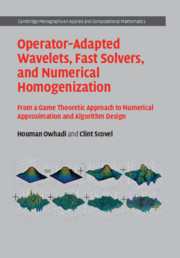 Operator-Adapted Wavelets, Fast Solvers, and Numerical Homogenization
Operator-Adapted Wavelets, Fast Solvers, and Numerical Homogenization from Part III - The Banach Space Setting
Published online by Cambridge University Press: 10 October 2019
The computation ofgamblets is accelerated by localizing their computation in a hierarchical manner (using a hierarchy of distances), and the approximation errors caused by these localization steps are bounded based on three properties: nesting, the well-conditioned nature of the linear systems solved in the Gamblet Transform, and theexponential decay of the gamblets. These efficiently computed, accurate, andlocalized gamblets are shown to producea Fast Gamblet Transform of near-linear complexity. Application to the three primary classes ofmeasurement functions in Sobolev spaces are developed.
To save this book to your Kindle, first ensure [email protected] is added to your Approved Personal Document E-mail List under your Personal Document Settings on the Manage Your Content and Devices page of your Amazon account. Then enter the ‘name’ part of your Kindle email address below. Find out more about saving to your Kindle.
Note you can select to save to either the @free.kindle.com or @kindle.com variations. ‘@free.kindle.com’ emails are free but can only be saved to your device when it is connected to wi-fi. ‘@kindle.com’ emails can be delivered even when you are not connected to wi-fi, but note that service fees apply.
Find out more about the Kindle Personal Document Service.
To save content items to your account, please confirm that you agree to abide by our usage policies. If this is the first time you use this feature, you will be asked to authorise Cambridge Core to connect with your account. Find out more about saving content to Dropbox.
To save content items to your account, please confirm that you agree to abide by our usage policies. If this is the first time you use this feature, you will be asked to authorise Cambridge Core to connect with your account. Find out more about saving content to Google Drive.